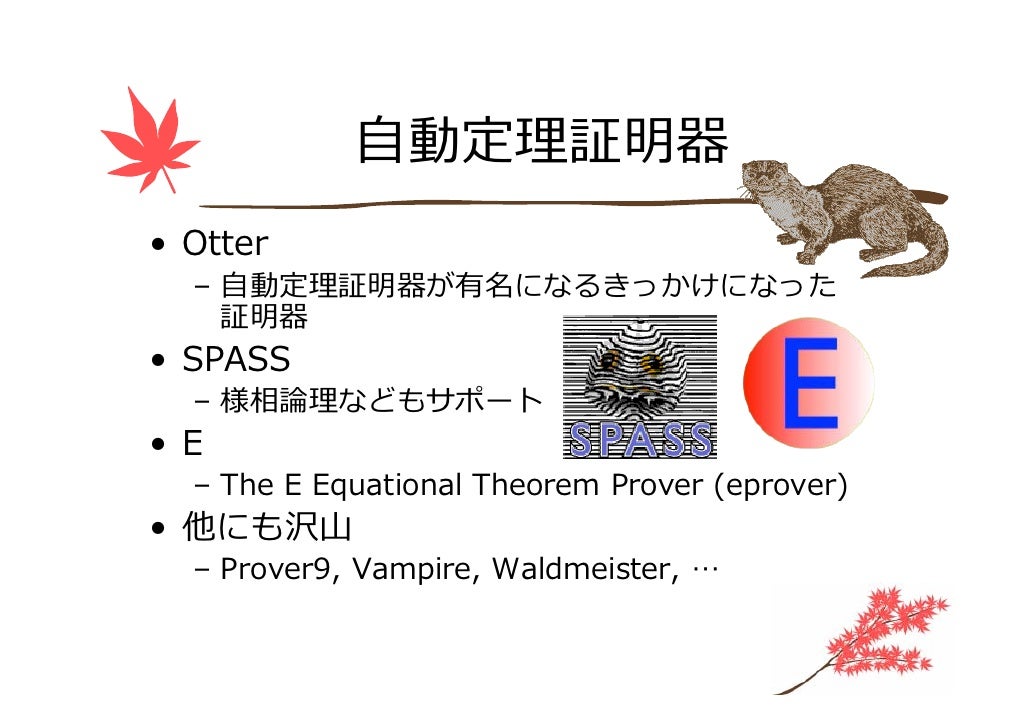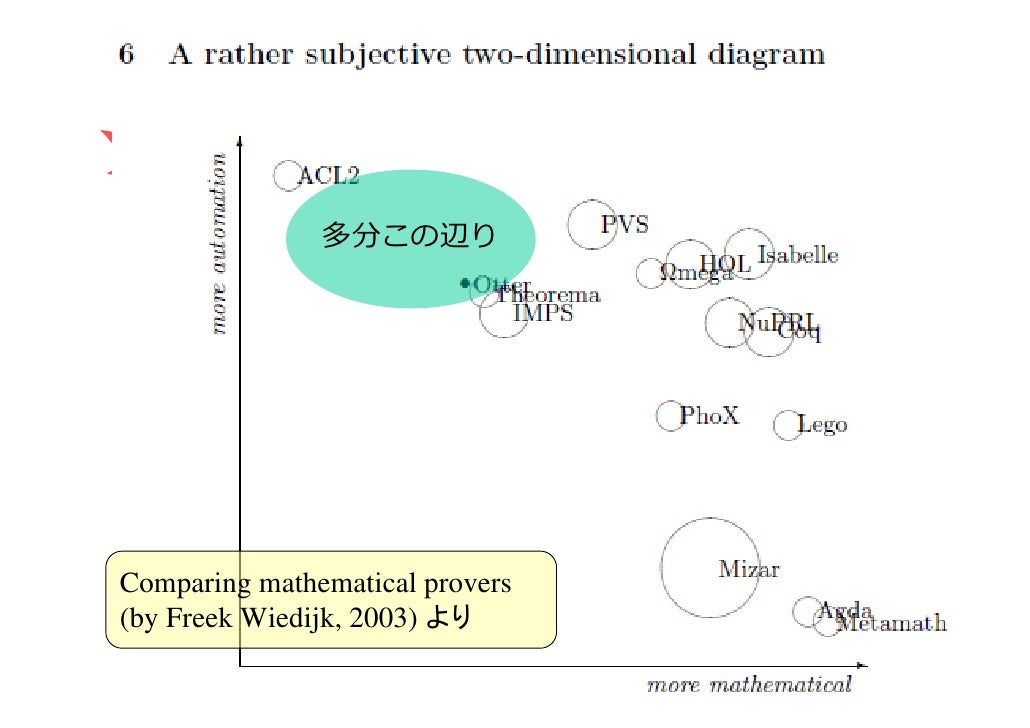Vampire Theorem Prover
This article may be too technical for most readers to understand. Please to, without removing the technical details. (December 2009) Vampire Alexandre Riazanov Kryštof Hoder Website Vampire is an for developed in the at the by together with Kryštof Hoder and previously with Alexandre Riazanov. So far it has won the 'world cup for theorem provers' (the ) in the most prestigious CNF (MIX) division eleven times (1999, 2001–2010). Background Vampire's implements the calculi of ordered and for handling equality. The splitting rule and negative equality splitting can be simulated by the introduction of new predicate definitions and dynamic folding of such definitions.

Vampire I Vampire is an automated theorem prover for FOL, developed by Andrei Voronkov, Alexandre Riazanov, and Krystof Hoder. I Uses: I Assisting mathematicians.
Otter Theorem Prover
- Vampire is a theorem prover, that is, a system able to prove theorems. More precisely, it proves theorems in first-order logic.
- Vampire is a theorem prover, that is, a system able to prove theorems. More precisely, it proves theorems in first-order logic.
A splitting is also supported. A number of standard redundancy criteria and simplification techniques are used for pruning the search space: deletion, resolution, rewriting by ordered unit equalities, basicness restrictions and irreducibility of substitution terms. The reduction ordering used is the standard. A number of efficient techniques are used to implement all major operations on sets of terms and clauses. Is used to accelerate forward matching. Although the kernel of the system works only with clausal normal forms, the preprocessor component accepts a problem in the full first-order logic syntax, clausifies it and performs a number of useful transformations before passing the result to the kernel. When a theorem is proven, the system produces a verifiable proof, which validates both the clausification phase and the refutation of the.
Along with proving theorems, Vampire has other related functionalities such as generating. Can be obtained from the system website. A somewhat outdated version is available under the as part of. References.
^ Riazanov, A.; (2002). 'The design and implementation of VAMPIRE'. AI Communications. 15 (2-3/2002): 91–110.
(PhD thesis of Dr. Alexandre Riazanov on the implementation of Vampire). Urban, J.; Hoder, K.; (2010). 'Evaluation of Automated Theorem Proving on the Mizar Mathematical Library'. Mathematical Software – ICMS 2010. Lecture Notes in Computer Science. 'The anatomy of vampire'.
Journal of Automated Reasoning. 15 (2): 237–265. External links. This -related article is a. You can help Wikipedia.
Contents. Logical foundations While the roots of formalised go back to, the end of the 19th and early 20th centuries saw the development of modern logic and formalised mathematics. 's (1879) introduced both a complete and what is essentially modern. His, published 1884, expressed (parts of) mathematics in formal logic. This approach was continued by and in their influential, first published 1910–1913, and with a revised second edition in 1927.
Russell and Whitehead thought they could derive all mathematical truth using axioms and inference rules of formal logic, in principle opening up the process to automatisation. In 1920, simplified a previous result by, leading to the and, in 1930, to the notion of a and a that allowed (un)satisfiability of first-order formulas (and hence the of a theorem) to be reduced to (potentially infinitely many) propositional satisfiability problems. In 1929, showed that the theory of with addition and equality (now called in his honor) is and gave an algorithm that could determine if a given sentence in the language was true or false. However, shortly after this positive result, published (1931), showing that in any sufficiently strong axiomatic system there are true statements which cannot be proved in the system. This topic was further developed in the 1930s by and, who on the one hand gave two independent but equivalent definitions of, and on the other gave concrete examples for undecidable questions.
First implementations Shortly after, the first general purpose computers became available. In 1954, programmed Presburger's algorithm for a vacuum tube computer at the.
According to Davis, 'Its great triumph was to prove that the sum of two even numbers is even'. More ambitious was the, a deduction system for the of the Principia Mathematica, developed by, and. Also running on a JOHNNIAC, the Logic Theory Machine constructed proofs from a small set of propositional axioms and three deduction rules:, (propositional) variable substitution, and the replacement of formulas by their definition. The system used heuristic guidance, and managed to prove 38 of the first 52 theorems of the Principia. The 'heuristic' approach of the Logic Theory Machine tried to emulate human mathematicians, and could not guarantee that a proof could be found for every valid theorem even in principle. In contrast, other, more systematic algorithms achieved, at least theoretically, for first-order logic. Initial approaches relied on the results of Herbrand and Skolem to convert a first-order formula into successively larger sets of propositional formulae by instantiating variables with terms from the.
The propositional formulas could then be checked for unsatisfiability using a number of methods. Gilmore's program used conversion to, a form in which the satisfiability of a formula is obvious. Decidability of the problem. This section does not any.
Unsourced material may be challenged and. (April 2010) Depending on the underlying logic, the problem of deciding the validity of a formula varies from trivial to impossible. For the frequent case of, the problem is decidable but, and hence only exponential-time algorithms are believed to exist for general proof tasks. For a, states that the theorems (provable statements) are exactly the logically valid, so identifying valid formulas is: given unbounded resources, any valid formula can eventually be proven. However, invalid formulas (those that are not entailed by a given theory), cannot always be recognized.
The above applies to first order theories, such as. However, for a specific model that may be described by a first order theory, some statements may be true but undecidable in the theory used to describe the model. For example, by, we know that any theory whose proper axioms are true for the natural numbers cannot prove all first order statements true for the natural numbers, even if the list of proper axioms is allowed to be infinite enumerable. It follows that an automated theorem prover will fail to terminate while searching for a proof precisely when the statement being investigated is undecidable in the theory being used, even if it is true in the model of interest. Despite this theoretical limit, in practice, theorem provers can solve many hard problems, even in models that are not fully described by any first order theory (such as the integers). Related problems A simpler, but related, problem is, where an existing proof for a theorem is certified valid. For this, it is generally required that each individual proof step can be verified by a or program, and hence the problem is always decidable.
Since the proofs generated by automated theorem provers are typically very large, the problem of is crucial and various techniques aiming at making the prover's output smaller, and consequently more easily understandable and checkable, have been developed. Require a human user to give hints to the system. Depending on the degree of automation, the prover can essentially be reduced to a proof checker, with the user providing the proof in a formal way, or significant proof tasks can be performed automatically.
Interactive provers are used for a variety of tasks, but even fully automatic systems have proved a number of interesting and hard theorems, including at least one that has eluded human mathematicians for a long time, namely the. However, these successes are sporadic, and work on hard problems usually requires a proficient user. Another distinction is sometimes drawn between theorem proving and other techniques, where a process is considered to be theorem proving if it consists of a traditional proof, starting with axioms and producing new inference steps using rules of inference. Other techniques would include, which, in the simplest case, involves brute-force enumeration of many possible states (although the actual implementation of model checkers requires much cleverness, and does not simply reduce to brute force). There are hybrid theorem proving systems which use model checking as an inference rule.
There are also programs which were written to prove a particular theorem, with a (usually informal) proof that if the program finishes with a certain result, then the theorem is true. A good example of this was the machine-aided proof of the, which was very controversial as the first claimed mathematical proof which was essentially impossible to verify by humans due to the enormous size of the program's calculation (such proofs are called ). Another example of a program-assisted proof is the one that shows that the game of can always be won by first player.
Industrial uses Commercial use of automated theorem proving is mostly concentrated in and verification. Since the, the complicated of modern microprocessors have been designed with extra scrutiny., and others use automated theorem proving to verify that division and other operations are correctly implemented in their processors. First-order theorem proving In the late 1960s agencies funding research in automated deduction began to emphasize the need for practical applications. One of the first fruitful areas was that of whereby first-order theorem provers were applied to the problem of verifying the correctness of computer programs in languages such as Pascal, Ada, Java etc. Notable among early program verification systems was the Stanford Pascal Verifier developed by David Luckham at Stanford University.
This was based on the Stanford Resolution Prover also developed at Stanford using J.A. Robinson's resolution Principle. This was the first automated deduction system to demonstrate an ability to solve mathematical problems that were announced in the Notices of the American Mathematical Society before solutions were formally published. Theorem proving is one of the most mature subfields of automated theorem proving. The logic is expressive enough to allow the specification of arbitrary problems, often in a reasonably natural and intuitive way. On the other hand, it is still semi-decidable, and a number of sound and complete calculi have been developed, enabling fully automated systems.
More expressive logics, such as, allow the convenient expression of a wider range of problems than first order logic, but theorem proving for these logics is less well developed. Benchmarks and competitions The quality of implemented systems has benefited from the existence of a large library of standard benchmark examples — the Thousands of Problems for Theorem Provers (TPTP) Problem Library — as well as from the (CASC), a yearly competition of first-order systems for many important classes of first-order problems. Some important systems (all have won at least one CASC competition division) are listed below. is a high-performance prover for full first-order logic, but built on a, developed primarily in the automated reasoning group of., developed at the, is based on and. Otter has since been replaced by, which is paired with. is a high-performance system based on the goal-directed calculus.
It is developed in the automated reasoning group of Technical University of Munich. E and SETHEO have been combined (with other systems) in the composite theorem prover E-SETHEO. is developed and implemented at by and, formerly also. It has won the CADE ATP System Competition in the most prestigious CNF (MIX) division for eleven years (1999, 2001–2010). Waldmeister is a specialized system for unit-equational first-order logic. It has won the CASC UEQ division for the last fourteen years (1997–2010). is a first order logic theorem prover with equality.
This is developed by the research group Automation of Logic,. Popular techniques. with.

and term. Comparison.